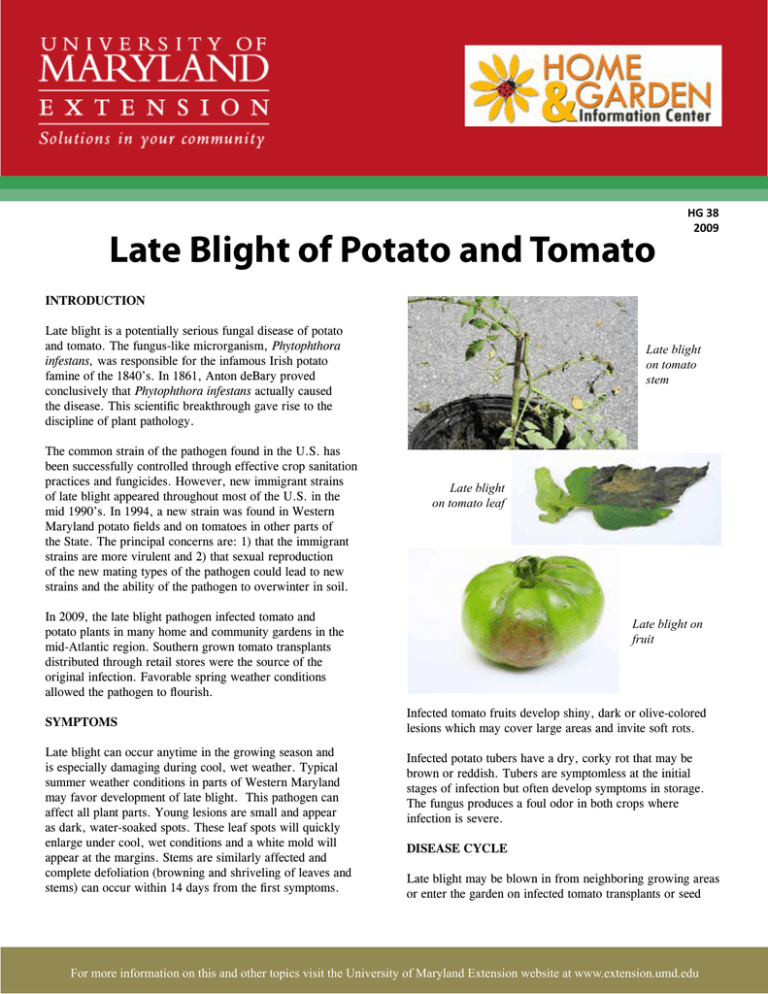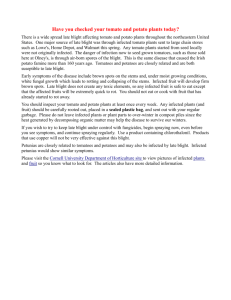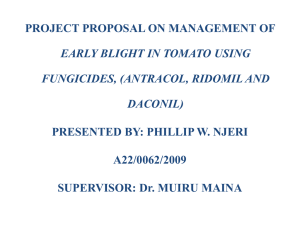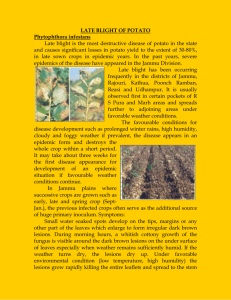Late Blight of Potato and Tomato
advertisement

Late Blight of Potato and Tomato HG 38 2009 INTRODUCTION Late blight is a potentially serious fungal disease of potato and tomato. The fungus-like microrganism, Phytophthora infestans, was responsible for the infamous Irish potato famine of the 1840’s. In 1861, Anton deBary proved conclusively that Phytophthora infestans actually caused the disease. This scientific breakthrough gave rise to the discipline of plant pathology. The common strain of the pathogen found in the U.S. has been successfully controlled through effective crop sanitation practices and fungicides. However, new immigrant strains of late blight appeared throughout most of the U.S. in the mid 1990’s. In 1994, a new strain was found in Western Maryland potato fields and on tomatoes in other parts of the State. The principal concerns are: 1) that the immigrant strains are more virulent and 2) that sexual reproduction of the new mating types of the pathogen could lead to new strains and the ability of the pathogen to overwinter in soil. Late blight on tomato stem Late blight on tomato leaf In 2009, the late blight pathogen infected tomato and potato plants in many home and community gardens in the mid-Atlantic region. Southern grown tomato transplants distributed through retail stores were the source of the original infection. Favorable spring weather conditions allowed the pathogen to flourish. SYMPTOMS Late blight can occur anytime in the growing season and is especially damaging during cool, wet weather. Typical summer weather conditions in parts of Western Maryland may favor development of late blight. This pathogen can affect all plant parts. Young lesions are small and appear as dark, water-soaked spots. These leaf spots will quickly enlarge under cool, wet conditions and a white mold will appear at the margins. Stems are similarly affected and complete defoliation (browning and shriveling of leaves and stems) can occur within 14 days from the first symptoms. Late blight on fruit Infected tomato fruits develop shiny, dark or olive-colored lesions which may cover large areas and invite soft rots. Infected potato tubers have a dry, corky rot that may be brown or reddish. Tubers are symptomless at the initial stages of infection but often develop symptoms in storage. The fungus produces a foul odor in both crops where infection is severe. DISEASE CYCLE Late blight may be blown in from neighboring growing areas or enter the garden on infected tomato transplants or seed 1 For more information on this and other topics visit the University of Maryland Extension website at www.extension.umd.edu Foliage and early fruit symptoms on tomato Early foliage symptoms on potato potatoes. The fungus may survive in un-harvested or cull tubers left in the garden over the winter but the common strain of the disease is not likely to overwinter on plant debris. Stem symptoms on potato Potato: 1. Do not plant store-bought potatoes or tubers harvested from blighted plants during the previous season. Always purchase new seed potatoes that are certified, “disease-free”. Spores are spread between plants and gardens by rain and wind. Infection of potato foliage begins when plants emerge from diseased seed potatoes. Spores on infected potato leaves are washed down into the soil where they may infect tubers. 2. ‘Kennebec’ and ‘Elba’ are resistant cultivars. 3. Keep developing tubers covered with soil to protect them from late blight. 4. If late blight is evident, harvest and eat tubers right away. Don’t store them. A combination of daytime temperatures in the upper 70s F and the low 80s F with high humidity (cloudy, rainy weather and morning dews) is ideal for infection. If suitable conditions continue the disease will spread rapidly. The spread of disease is slowed by hot, dry weather (temperatures over 95F). However, a return to wetter cooler weather will renew the spread of the disease. 5. Do not compost store-bought potatoes. For potato and tomato: 1. Pull-out and remove plants with late blight symptoms. This will protect your neighbors’ gardens and local farmers. Put plants in a large plastic bag, seal the bag and leave it out in the sunshine to “bake” for a few days before putting it in a trash can. This will help to kill the pathogen and prevent it from infecting your garden next season. Do not attempt to compost infected plants. PREVENTION AND MANAGEMENT This is a destructive disease. Contact horticulture consultants at HGIC (800-342-2507) or “send a question” via our web site (http://extension.umd.edu/hgic) if you have questions about your tomato and potato plants. The following steps can be taken to minimize late blight problems: 2. You cannot “cure” this disease once you see the symptoms. Again, remove the infected plants. 3. In years when late blight is detected in your area, fungicides like chlorothalonil and fixed copper can help protect “clean”, un-infected plants if sprayed on all plant parts on a regular basis. General garden advice: 1. Locate your garden on well-drained soil where it will receive morning sun. 2. Allow extra room between potato and tomato plants to encourage rapid drying of leaves. 3. Water around the base of plants and avoid wetting foliage in early evening. Reviewed by: W.E. Fry, Ph.D., Dept. of Pathology, Cornell University. 4. Prevent weed growth; weeds can limit air circulation around plants and weeds in the tomato family (Solanaceae) can be infected by late blight. References: Sherf, A.F. and A.A. McNab. 1986. Vegetable Diseases and Their Control, 2nd Ed. John Wiley & Sons, Inc. 728 pp. Tomato: 1. Buy locally grown transplants or start your own at home. Agrios, G.N. 1988. Plant Pathology, 3rd Ed. Academic Press, Inc. 803 pp. 2. Learn to distinguish the symptoms of late blight from those of other common tomato diseases, like early blight and Septoria leaf spot. 2 Do you have a plant or insect pest question? Visit us at extension.umd.edu/hgic and click Ask Maryland’s Garden Experts Author: Jon Traunfeld, University of Maryland Extension Specialist, Home and Garden Information Center This publication is a series of publications of the University of Maryland Extension and The Home and Garden Information Center. For more information on related publications and programs, http://extension.umd.edu/hgic. Please visit http://extension.umd.edu/ to find out more about Extension programs in Maryland. The University of Maryland, College of Agriculture and Natural Resources programs are open to all and will not discriminate against anyone because of race, age, sex, color, sexual orientation, physical or mental disability, religion, ancestry, or national origin, marital status, genetic information, or political affiliation, or gender identity and expression. 3 For more information on this and other topics visit the University of Maryland Extension website at http://extension.umd.edu


